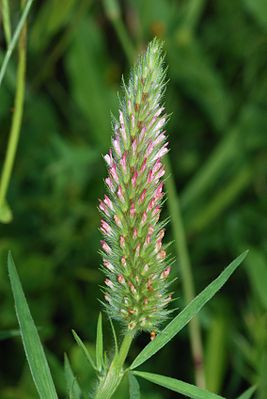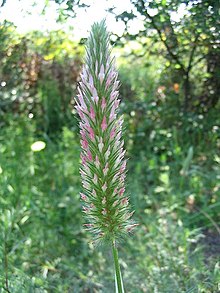Narrow-leaved clover
| Narrow-leaved clover | ||||||||||||
|---|---|---|---|---|---|---|---|---|---|---|---|---|

Narrow-leaved clover ( Trifolium angustifolium ) |
||||||||||||
| Systematics | ||||||||||||
|
||||||||||||
| Scientific name | ||||||||||||
| Trifolium angustifolium | ||||||||||||
| L. |
The narrow-leaved clover ( Trifolium angustifolium ) is a species of the genus Klee ( Trifolium ) in the legume family (Fabaceae). It is placed in the genus in the section Trifolium , subsection Angustifolia .
description
The narrow-leaved clover is an annual , herbaceous plant that reaches heights of between 15 and 50 centimeters. The stems are erect, stiff, branched at the base and hairy adjacent to them . The lateral shoots are shorter and ascending.
The three-part leaves are long in the lower part of the plant and short stalked in the upper part. The stipules are about half grown together with the petioles. The free part is lanceolate with many distinct leaf veins and an awl tip.
The leaflets are between 3 and 5 inches long and 0.2 to 0.4 inches wide. They are usually longer than the petioles. They are narrowly lanceolate to linear, pointed in the upper leaves and obtuse in the lower leaves. Both leaf sides are hairy when pressed. The leaf margin is entire or almost entire.
The narrow-leaved clover blooms from March to July. The head-packed inflorescences are cylindrical or conical spikes . They become 3 to 8 inches long and consist of 1 to 1.3 inches long butterfly flowers .
The calyx has ten nerves and a tubular to bell-shaped shape and is covered with close-fitting to protruding, stiff hair that grows out of bumps. The calyx teeth are sub-bristle-shaped with sharp bare tips that are stiff when ripe and stinging. The lower ones are longer than the upper ones. The crown is pink to purple and as long as the calyx teeth or just a little longer.
When the fruit ripens, solitary egg-shaped, membranous pods with a cartilage-like seed cover (operculum) are formed. They mature in the completely closed calyx tube. The calyx teeth stand out in a star shape. The seed is egg-shaped and light brown in color.
The number of chromosomes is 2n = 16 or 14.
Occurrence
The narrow-leaved clover occurs in all countries of the Mediterranean area except for the Sinai Peninsula . In the north it reaches the southern edge of the Alps , Romania and the former Czechoslovakia. In the west it lives on all the islands of the Canary Islands and the Madeira archipelago and on all the islands of the Azores except Graciosa, Flores and Corvo. In the east it occurs in the Caucasus countries and in northern Iraq and Iran . It is firmly naturalized in Chile , South Africa and southern Australia , possibly also in New Zealand , California and Oregon . This clover colonizes gaps in vegetation and open soils in dry cultivated and pastureland up to altitudes of up to 1300 meters and prefers soils that are rather poor in base.
Systematics
The species name Trifolium angustifolium was first published in 1753 by Carl von Linné in Species Plantarum . The narrow-leaved clover is placed in the genus in the section Trifolium, subsection Angustifolia.
Individual evidence
- ^ A b c Ehrentraud Bayer, Karl Peter Buttler, Xaver Finkenzeller, Jürke Grau: Plants of the Mediterranean (= Steinbach's natural guide . Volume 17 ). Mosaik, Munich 1987, ISBN 3-570-01347-2 , p. 72 .
- ↑ a b c d Michael Zohary, David Heller: The Genus Trifolium . The Israel Academy of Sciences and Humanities, Jerusalem 1984, ISBN 965-208-056-X , pp. 447-450 .
- ↑ a b Ralf Jahn, Peter Schönfelder: Excursion flora for Crete . With contributions by Alfred Mayer and Martin Scheuerer. Eugen Ulmer, Stuttgart (Hohenheim) 1995, ISBN 3-8001-3478-0 , p. 166 .
- ^ J. Chr. Van Loon: A cytotaxonomical atlas of the Balkan flora. Bornträger Brothers, Berlin & Stuttgart 1987, ISBN 3-443-63001-4 , p. 99
- ↑ Werner Greuter, Hervé-Maurice Burdet, Guy Long (eds.): Med-Checklist. A critical inventory of vascular plants of the circum-Mediterranean countries . Vol. 4: Dicotyledones (Lauraceae - Rhamnaceae) . Conservatoire et Jardin Botanique, Genève 1989, ISBN 2-8277-0154-5 . (online) .
- ^ Sandro Pignatti (ed.): Flora d'Italia . Vol. 1. Edagricole, Bologna 2003, ISBN 88-506-2449-2 , pp. 739 (third unaltered reprint of the 1st edition from 1982).
- ↑ DE Coombe: Trifolium in TG Tutin, VH Heywood, NA Burges, DM Moore, DH Valentine, SM Walters, DA Webb (eds.): Flora Europaea . Volume 2: Rosaceae to Umbelliferae . Cambridge University Press, Cambridge 1968, ISBN 0-521-06662-X , pp. 170 (English, limited preview in Google Book Search).
- ^ Alfred Hansen, Per Sunding: Flora of Macaronesia. Checklist of vascular plants . In: Sommerfeltia . 4th edition. tape 17 , 1993, p. 126-127 .
- ^ Peter Hadland Davis (ed.): Flora of Turkey and the East Aegean Islands. Vol. 3 (Leguminosae) . Edinburgh University Press, Edinburgh 1970, ISBN 0-85224-154-2 , pp. 434 .
- ↑ Chileflora.com
- ↑ SANBI red list .
- ↑ FloraBase - The West Australian Flora , accessed August 27, 2010
- ↑ CJ Webb, WR Sykes, PJ Garnock-Jones: Flora of New Zealand Volume IV: Naturalized Pteridophytes, Gymnosperms, Dicotyledons. 1988, ISBN 0-477-02529-3 , Trifolium angustifolium online
- ↑ James C. Hickman (Ed.): The Jepson Manual. Higher Plants of California . University of California Press, Berkeley, Calif 1993, ISBN 0-520-08255-9 . on-line
- ↑ Carl von Linné: Species Plantarum. Volume 2, Impensis Laurentii Salvii, Holmiae 1753, p. 769, digitized .
Web links
- Thomas Meyer, Michael Hassler: Mediterranean flora. [1]
